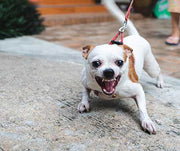Muzzle Dog Tips

There is a stigma attached to the dog muzzle that is out of line with its usefulness. Some consider the muzzle a sign of animal cruelty. However, muzzles are useful when a dog needs to be moved in difficult circumstances, or when he needs to be protected from himself or herself. For example, if a pet is ever injured or frightened, it may bite out of panic and pain; it may be necessary to muzzle them in these circumstances.
As another example, a dog might need to be moved quickly, like during a storm, fire, or natural disaster. Dogs often bite in times of fear, and there may be times when a dog needs to be moved forcibly, which is why it's important not to wait to introduce your dog to a muzzle.
In this post, we'll give pet parents tips on introducing dogs to muzzles, how to get them comfortable with muzzles, and how to gradually increase the amount of time your dog can stay in a muzzle. As always, remember to be patient and kind when introducing your dog to something new.
STEP 1: Introduce the Muzzle Gently
In the same way, it's recommended to make a dog's crate a desirable and fun place while you're training, the muzzle should be an equally gentle, positive experience for your dog. If you put him or her in a muzzle as a punishment, they will associate it with stress and fight you every time you need to put it on. Giving your dog lots of treats before and after using the muzzle is a great way to gently train your dog.
Once the dog is comfortable with the muzzle, you can slip it on his nose and then remove it quickly; make sure you give your dog a treat right after this. Giving treats will help your dog feel settled with the unfamiliar sensation of a muzzle closing around his mouth. The less stressed your dog is while muzzle training, the better.
STEP 2: Encourage Further Investigation with Treats
Placing a treat into the muzzle can be a great way to encourage your dog to be curious about it, as well as, to help him think of the muzzle as a positive instrument. Don't put the muzzle on right away. Rather, let the dog practice putting his nose in it on his own. Having patience and doing it this way will give your dog time to become familiar with it and know that it's safe for him. This exploration of the muzzle can later be paired with the command "muzzle on."
STEP 3: Gradually Increase Time in the Muzzle
After this stress-free introduction, slowly increase the amount of time that the muzzle is on your dog's face. This can start by putting the muzzle on, but not buttoning it, allowing your dog to walk around with it on unsecured.
After your dog gets more comfortable with it, you can transition to buttoning it briefly and leaving it on for increased increments of time. If your dog appears agitated or highly distressed, do not continue muzzle training. Remember, all steps during the muzzle training process should feel gradual and stress-free for your dog.
Additional Tips
- Start off with a basket muzzle vs. a muzzle made from fabric. Basket muzzles tend to be more loose-fitting which helps dogs feel more relaxed because they can still pant, drink, and eat. As your dog gets used to a muzzle, you can then move on to a muzzle made from fabric.
- Make sure all muzzles are placed right side up, as misplacement can cause discomfort for dogs.
- Don't use a muzzle sporadically, as a punishment, or because you might find it convenient one day. It should only be used for things like emergencies, veterinary care, and training. Inconsistent use can make your dog frustrated and confused, and will make muzzling him or her much harder.
Conclusion
There are certain times a dog may be required to be muzzled. It's important to get your dog familiar with a muzzle just in case of emergencies out of your control. Remember to have patience and take your time when getting your dog familiar with a muzzle and as always, consult with your vet if you have any concerns.
Previous article

Next article

Related posts
View all-

How to Keep Your Pet Calm During Thanksgiving
Thanksgiving is a time for family, friends, and food, but for our pets, the holiday can be overwhelming. The sudden change in routine, unfamiliar faces and scents, and increased noise can trigger significant stress. Understanding why your pet might feel anxious is the first step toward creating a peaceful holiday experience for everyone, including your furry family members. This guide offers calming tips for pets and practical solutions to ensure your dog or cat feels safe and secure during the festivities.
Read Article -

Top Travel Essentials for Pets This Holiday Season
Holiday travel often means bringing the whole family along, and for many of us, that includes our furry companions. Preparing for holiday pet travel is about more than just packing a bag; it's about ensuring your pet's safety, comfort, and happiness from the moment you leave home until you return. A little planning helps reduce stress for both you and your pet, making the journey a positive experience for everyone involved.
Read Article -

Best Leashes and Collars for Daily Walks: A Pet Parent’s Guide
A daily walk with your dog isn't just a chore—it's a chance to bond, explore, and stay active together. The right leash and collar can make every walk safer and more enjoyable for both of you. With numerous styles and materials available, it's essential to find gear that suits your dog's needs and your lifestyle.
Read Article



